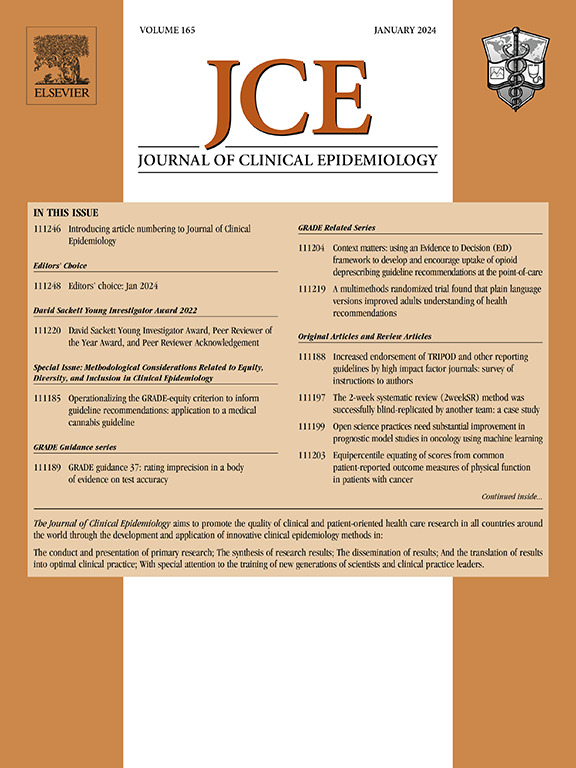Analysis of risk of bias assessments in a sample of intervention systematic reviews, Part II: focus on risk of bias tools reveals few meet current appraisal standards
IF 7.3
2区 医学
Q1 HEALTH CARE SCIENCES & SERVICES
引用次数: 0
Abstract
Objectives
Risk of bias (RoB) assessment is a critical part of any systematic review (SR). There are multiple tools available for assessing RoB of the studies included in a SR. The conduct of these assessments in intervention SRs are addressed by three items in AMSTAR-2, considered the preferred tool for critically appraising an intervention SR. This study focuses attention on item 9, which assesses the ability of a RoB tool to adequately address sources of bias, particularly in randomized trials (RCTs) and nonrandomized studies of interventions (NRSI). Our main objective is to report the detailed results of our examination of both Cochrane and non-Cochrane RoB tools and distinguish those that meet AMSTAR-2 item 9 appraisal standards.
Study Design and Setting
We identified critical appraisal tools reported in a sample of 126 SRs reporting on interventions for persons with cerebral palsy published from 2014 to 2021. Eligible tools were those that had been used to assess the primary studies included in these SRs and for which assessment results were reported in enough detail to allow appraisal of the tool. We identified the version of the tool applied as original, modified, or novel and established the applicable study designs as intended by the tools’ developers. We then evaluated the potential ability of these tools to assess the four sources of bias specified in AMSTAR-2 item 9 for RCTs and NRSI. We adapted item 9 to appraise tools applied to single-case experimental designs, which we also encountered in this sample of SRs.
Results
Most of the eligible tools are recognized by name in the published literature and were applied in the original or modified form. Modifications were applied with considerable variability across the sample. Of the 37 tools we examined, those judged to fully meet the appraisal standards for RCTs included all the Cochrane tools, the original and modified Downs and Black Checklist, and the quality assessment standard for a cross-over study by Ding et al; for NRSI, these included all the Cochrane tools, the original and modified Downs and Black Checklist, and the Research Triangle Institute item bank on Risk of Bias and Precision of Observational Studies for NRSI. In general, tools developed for a specific study design were judged to meet the appraisal standards fully or partially for that design. These results suggest it is unlikely that a single tool will be adequate by AMSTAR-2 item 9 appraisal standards for an intervention SR that includes studies of various designs.
Conclusion
To our knowledge, this is the first resource providing SR authors with practical information about the appropriateness and adequacy of RoB tools by the appraisal standards specified in AMSTAR-2 item 9 for RCTs and NRSI. We propose similar methods for appraisal of tools applied to single-case experimental design. We encourage authors to seek contemporary RoB tools developed for use in healthcare-related intervention SRs and designed to evaluate relevant study design features. The tools should address attributes unique to the review topic and research question but not be subjected to unjustified and excessive modifications. We promote recognition of the potential shortcomings of both Cochrane and non-Cochrane RoB tools, even those that perform well by AMSTAR-2 item 9 appraisal standards.
干预性系统综述样本的偏倚风险评估分析,第二部分:偏倚风险工具的重点显示,符合当前评估标准的工具寥寥无几。
目的:偏倚风险(RoB)评估是任何系统综述(SR)的关键部分。有多种工具可用于评估纳入系统综述的研究的偏倚风险。AMSTAR-2 被认为是对干预性系统综述进行批判性评估的首选工具,其中有三个项目涉及干预性系统综述中进行这些评估的问题。本研究重点关注项目 9,该项目评估 RoB 工具充分解决偏倚来源的能力,尤其是随机试验 (RCT) 和非随机干预研究 (NRSI) 中的偏倚来源。我们的主要目的是报告对 Cochrane 和非 Cochrane RoB 工具的详细检查结果,并区分那些符合 AMSTAR-2 第 9 项评估标准的工具:我们在2014年至2021年发表的126篇报告中抽样调查了对脑瘫患者干预措施的关键评估工具。符合条件的工具是那些用于评估这些SR中包含的主要研究的工具,并且评估结果有足够详细的报告,以便对工具进行评估。我们确定了所应用工具的原始版本、修改版本或新型版本,并按照工具开发者的意图确定了适用的研究设计。然后,我们评估了这些工具评估 AMSTAR-2 第 9 项针对 RCT 和 NRSI 规定的四种偏倚来源的潜在能力。我们对第 9 项进行了调整,以评估适用于单例实验设计的工具,我们在 SR 样本中也遇到了这种情况:结果:大多数符合条件的工具在已发表的文献中都有名称,并以原始或修改后的形式应用。修改后的工具在样本中的应用具有相当大的差异性。在我们检查的 37 种工具中,被判定完全符合 RCT 评估标准的工具包括所有 Cochrane 工具、原始和修改后的 Downs 和 Black 检查表,以及 Ding 等人的交叉研究质量评估标准;对于 NRSI,这些工具包括所有 Cochrane 工具、原始和修改后的 Downs 和 Black 检查表,以及三角研究所的 NRSI 观察性研究偏倚风险和精确性项目库。一般来说,为特定研究设计开发的工具被判定为完全或部分符合该设计的鉴定标准。这些结果表明,根据 AMSTAR-2 第 9 项评估标准,单一工具不太可能满足包括各种设计研究在内的干预 SR 的要求:据我们所知,这是第一份为SR作者提供实用信息的资料,介绍了RoB工具在AMSTAR-2第9项规定的RCT和NRSI评估标准下的适宜性和充分性。我们建议采用类似的方法来评估适用于单例实验设计的工具。我们鼓励作者寻找为医疗相关干预性研究开发的、旨在评估相关研究设计特征的当代 RoB 工具。这些工具应针对综述主题和研究问题的独特属性,但不应进行不合理的过度修改。我们提倡认识到 Cochrane 和非 Cochrane RoB 工具的潜在缺陷,即使是那些在 AMSTAR-2 第 9 项评估标准中表现良好的工具。
本文章由计算机程序翻译,如有差异,请以英文原文为准。
求助全文
约1分钟内获得全文
求助全文
来源期刊

Journal of Clinical Epidemiology
医学-公共卫生、环境卫生与职业卫生
CiteScore
12.00
自引率
6.90%
发文量
320
审稿时长
44 days
期刊介绍:
The Journal of Clinical Epidemiology strives to enhance the quality of clinical and patient-oriented healthcare research by advancing and applying innovative methods in conducting, presenting, synthesizing, disseminating, and translating research results into optimal clinical practice. Special emphasis is placed on training new generations of scientists and clinical practice leaders.
 求助内容:
求助内容: 应助结果提醒方式:
应助结果提醒方式:


